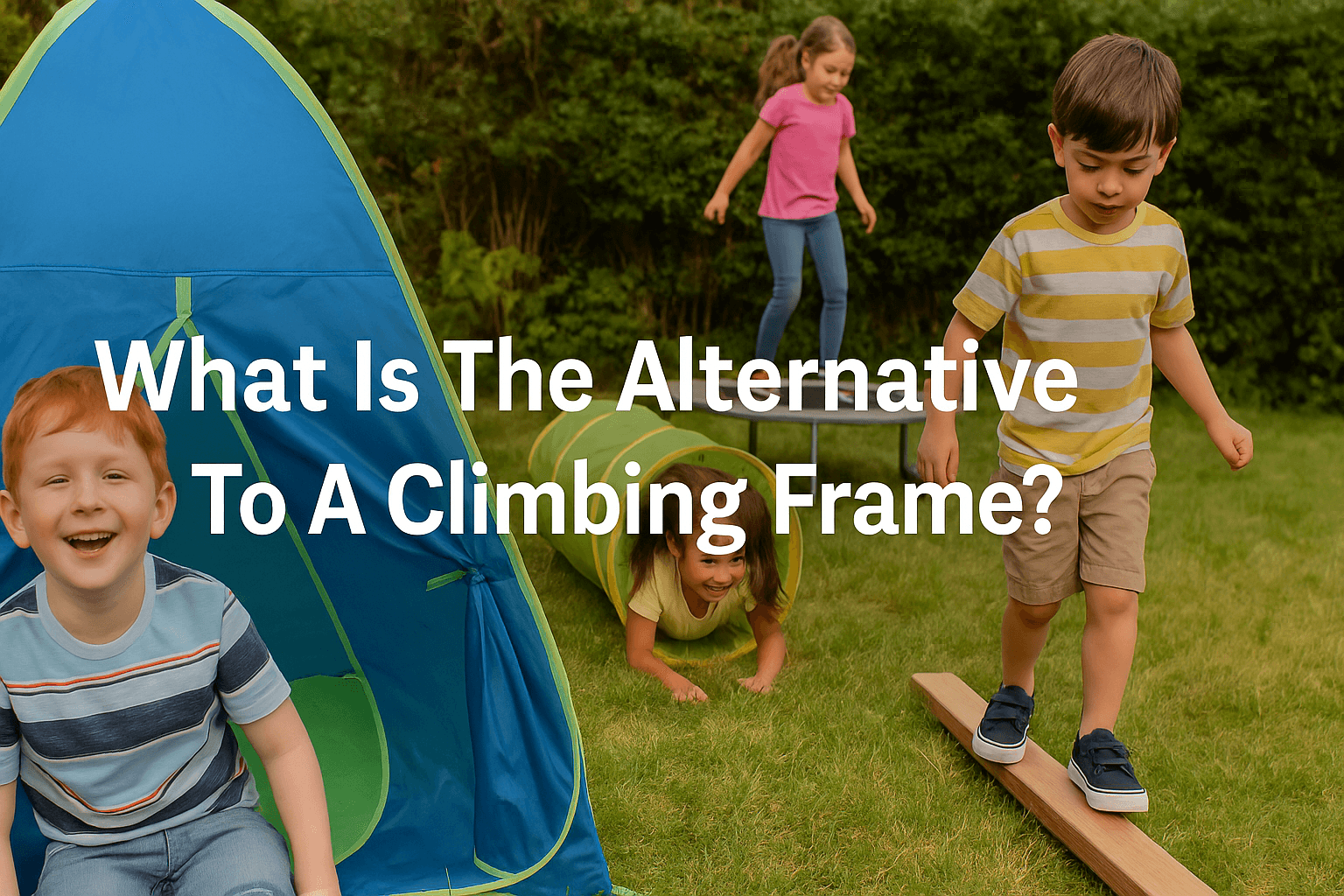
What Is The Alternative To A Climbing Frame?
No room for a wooden climbing frame? No problem! From pop-up tents to balance boards, there are heaps of fun, space-saving ways to keep kids climbing, jumping, and giggling.
Short answer: yes, there are great alternatives—and some might even be better.
Stick with us to find the one that suits your space, your budget, and your kids’ energy levels.
Exploring Alternatives to Traditional Climbing Frames
Play Structures Focusing on Different Skills
Swings and Slides (classic outdoor fun)
Let’s be honest—swings and slides are the OGs of outdoor play. You don’t need a full wooden climbing frame to give your little one that thrill. A simple swing tied to a sturdy tree or a small garden slide still does the trick.
They’re easy to set up, don’t take over your garden, and kids never seem to tire of them. Add a tyre swing or a plastic slide into the mix, and you’ve got a mini playground with minimal fuss.
Sandpits and Water Tables (sensory and creative play)
Sand and water—two things kids will never say no to.
A compact sandpit can keep little hands busy for hours. Think castles, tunnels, or even "cooking" pretend soup with leaves and stones. Water tables? Brilliant on a hot day. Kids can scoop, splash, pour and pretend they’re running a car wash or a café.
Messy, yes. Worth it? Definitely.
Trampolines (bouncing, gross motor skills)
If there’s one thing that rivals a climbing frame in the energy-burn department, it’s a trampoline. Whether it’s a full-sized one in the garden or a mini rebounder in the lounge, kids love them.
And it's not just bouncing—they're working on coordination, balance, and confidence without even realising. Plus, it wears them out just in time for dinner.
Big win.

Space-Saving and Indoor Options
Indoor Climbing Walls or Bouldering Boards
Short on garden space? Bring the climbing indoors.
Doorway climbing bars or foldable triangles are surprisingly sturdy and don’t hog your floor. Perfect for rainy days or flat living. You can fold them away, stash them behind the sofa, or even mount them to a bedroom wall.
Think of it as a climbing gym... disguised as furniture.
Play Tents and Tunnels
Sometimes, all you need is a tent and a bit of imagination.
Pop-up tents and tunnels are brilliant for smaller homes. They set up in seconds and pack away just as fast. One minute it’s a pirate ship, the next a dragon’s lair. The magic is in the storytelling—and the crawling, ducking and diving adds a sneaky bit of exercise too.
Gymnastic Bars or Rings (indoor strength building)
Got a doorway? Then you’ve got a gym.
Gymnastic rings or bars can help kids build strength and coordination, all while pretending to be circus performers. They’re adjustable, don’t take up much room, and best of all—they’re fun.
You’ll probably catch yourself having a go too.
Encouraging Active Play Without a Frame
DIY and Natural Play Solutions
Treehouses and Forts (imaginative play, natural climbing)
If you’ve got a tree, you’ve got potential.
Treehouses and forts can be as simple or fancy as you like. A few planks and a blanket? That’s a den. Add a ladder and it’s suddenly a spy base. These spaces become their own little world—somewhere kids can climb, hide, and let their imagination go wild.
Plus, it’s a fun family project to build together.
Obstacle Courses (cones, tyres, planks)
Obstacle courses are a brilliant way to burn off energy.
You can set one up in five minutes using stuff you’ve already got. Old tyres, plant pots, a plank over two buckets—suddenly your garden is a ninja warrior zone. Kids can crawl under, hop over, and balance their way through. You can even time them and see who beats the record.
Guaranteed giggles—and maybe a bit of friendly competition.
Slacklines and Balance Beams
Ever watched a child walk along a low brick wall like it’s a tightrope? That’s exactly what a balance beam taps into.
A slackline strung between two trees, or a low homemade beam, can keep kids practising for ages. They’re working on balance, coordination, and focus. It’s challenging, but also weirdly calming.
Plus, it’s one of the few outdoor toys adults love having a go on too.

Focus on Sports and Group Activities
Portable Goals (football, basketball)
You don’t need a fancy setup to kick a ball around.
A portable football goal or adjustable basketball hoop adds hours of play to any driveway or bit of grass. It’s brilliant for solo practice or full-on sibling tournaments. And when they’re done? Pack it away or drag it to the park.
Simple, affordable, and keeps them moving.
Garden Games (badminton, croquet)
Garden games aren’t just for grandma’s summer party.
Badminton is fast-paced, and croquet’s sneaky strategy gets kids thinking while they play. Games like boules, lawn darts, or even frisbee offer a chance for friendly competition and active fun without needing big kit.
Great for weekends, parties, or just dragging everyone outside after tea.
Bikes, Scooters, and Skateboards
These are the ultimate freedom machines.
Whether it’s a balance bike for a toddler or a skateboard for a teen, wheels mean movement. And confidence. And scraped knees—let’s be honest. But it also means adventures, independence, and the kind of active play that doesn’t feel like “exercise”.
From driveways to parks, they’re a brilliant climbing frame alternative that grows with your child.
Benefits of Alternative Play Solutions
Diverse Skill Development
Enhancing Different Physical and Cognitive Abilities
The beauty of these alternatives? They don’t just get kids moving—they help them grow in all directions.
Trampolines boost coordination. Balance beams train focus. Obstacle courses build problem-solving. It’s not about one type of movement—it’s about giving kids a full mix of challenges, all in their own back garden.
And most of the time? They’re just having fun.
Promoting Creativity and Imaginative Play
When play isn’t too structured, creativity soars.
Give them a sandpit, and you’ll see a bakery, a building site, and a dinosaur dig all in one afternoon. A play tent becomes a time machine. The less defined the toy, the more their imagination fills in the blanks.
That’s the secret to long-lasting, meaningful play.

Flexibility and Adaptability
Suiting Smaller Spaces or Different Budgets
Climbing frames are great—if you’ve got the space and the cash.
But pop-up play tents, tyre swings, and DIY forts can deliver just as much fun without breaking the bank or taking over your garden. It’s all about finding the right fit for your family, not sticking to a set template.
Sometimes less really is more.
Ease of Relocation or Storage
What’s brilliant about many of these alternatives is how easily they disappear when you need them to.
Fold it up, pack it down, or stash it in the shed. No need for permanent fixtures or a full garden redesign. Perfect for renters, shared gardens, or just people who like their lawn back on a weekend.
Have you checked out our other posts?
What Are Climbing Frames Made From?



Leave a comment